My first love is art. In fact, I started my college career pursuing fine art. But after obtaining my 2-year degree, I switched paths and finished my bachelor's in elementary education. I love teaching, too. There is no question--- I made the right choice. However, there are days when I want to immerse myself in colors and lines, to create and experiment, to bring my love of art to my students. The struggle is where to find the time (and the resources).
That's where Art With Jenny K comes in. No matter what I want to do, she has something that will work! Her detailed, easy-to-follow instructions help guide me to guide my students and the results are nothing less than spectacular.
Here is a small sampling of what she offers:
COLLABORATION POSTERS
My students love these. They love contributing to something bigger than them. It is especially gratifying when they start to assemble the final product and are guessing at what it will be. When we complete collaboration posters of famous people, the discussion always turns to who the people are and why they are famous. I love it when they are stumped my someone and then race to the computer in order to Google the name.
 |
| Black History Month |
 |
| Women's History Month (I printed the grid on pink paper) |
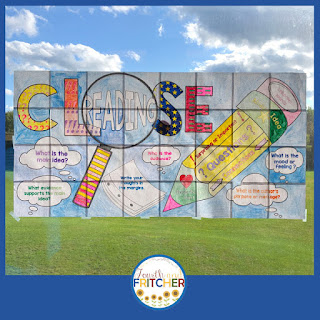 |
| Close Reading (this was a great team-builder to kick off the school year) |
You can find these and more here:
DIRECTED DRAWING
I love this little bunny freebie. It was a perfect project to complete just before Easter. The step-by-step instructions gave students enough support to feel accomplished yet enough creative freedom to make it their own. Every student brought his/her bunny home with a smile of pride on their face. I went a bit beyond the usual colored pencils and/or crayons and had the students mix the media. They were encouraged to use watercolor as well. The results were stunning!

This little cutie is at the following link:
Other FREEBIES are here:
BEAUTIFUL BULLETIN BOARDS
Bulletin Board. Just those two words can send a shiver down a teacher's back. I don't worry about them anymore. If I am in a pinch and need something seasonal and authentic to the students' work, Jenny K has some amazing things available!
I will disclose that neither board below was a quick project. Both took a bit of extra time. However, that is the trade off for beautiful student work that has a better chance in a memory box rather than the garbage.
This pumpkin project was brought to my attention because I subscribe to Jenny's email list. I highly recommend you scooch over to her blog and sign up! Click the link below and fill in the fields on the top right portion of her blog.
This template came through my email one morning and I decided to give a whirl. It was multi-step and required thought, precision, and grit. When completed, I used the pumpkins to create a fall bulletin board. The staff and other students loved the board and my class was constantly complemented on their efforts.
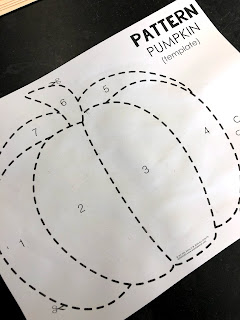 |
| The Template |
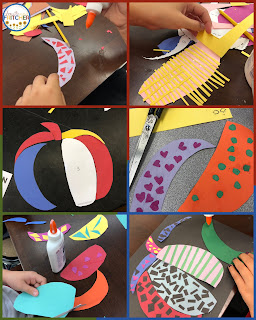 |
| Pumpkin Creation (2-3 days, 30 min/day) |
You can find the template for the pumpkin project here:
Agamographs are a struggle the first time you make them. But if you stick to it, the students will get faster and more precise each time. I love the challenge this art project offers. Students need to work fine-motor skills during the coloring. Then, they need to use precision and patience to get them folded correctly. An added bonus to this project is the ELA component. Students research the holiday and write down a few facts to share. The facts are displayed underneath each agamograph.
 |
| Christmas Around the World Agamographs |
You can find more agamographs here:
Similar to collaboration posters are Jenny's Famous Faces™ Unscramble Portraits. The difference is the students can work independently to complete them. They are smaller than a poster and are completed a little more quickly.
For Pi Day last year I had the students complete an Albert Einstein Unscramble. The directions included more than one option so that students of different abilities were able to successfully complete the portrait. Some students chose to use the preprinted drawing, other students chose to take on the challenge of drawing the lines themselves!
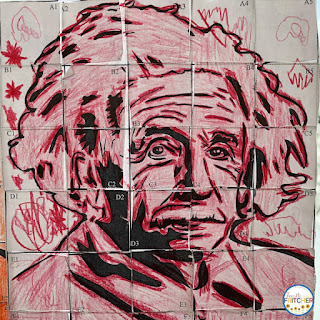 |
| Completed using the preprinted drawing. |
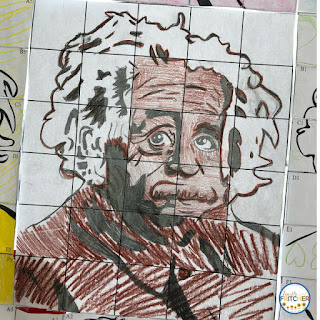 |
| Completed using the grid to draw the portrait! |
 |
| The collective result! |
More Famous Faces Unscramble Portraits are here:
Now, aside from all these amazing art projects, she also offers art-infused lessons! No matter what you are looking for, she has it! For students who are artistically-inclined, the combination of content and art is a nice break from the constant barrage of curriculum that can sometimes happen when we are trying to get through the material. The switching back and forth between the hemispheres in their brains helps keep them charged and engaged.
Jenny teamed up with Mary Beth from Brain Waves Instruction to create a wonderfully balanced resource that incorporates differentiated passages and artistic response.
I have used a lot of these non-fiction reading comprehension passages. It is especially helpful that they are leveled. These passages are quick print-and-go. Love, love, love them!
To see even more of what Art with Jenny K can do for you, click the link below, explore, and don't forget to click on the GREEN STAR to follow her. You won't be disappointed!
Thank you, thank you, Jenny K! My class, my bulletin boards, and I are so very grateful for the beauty and art you bring to our classroom year round.
Happy Thanksgiving!